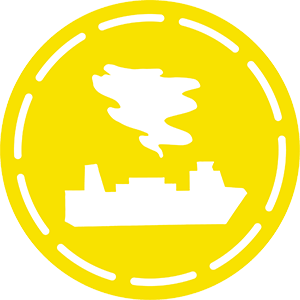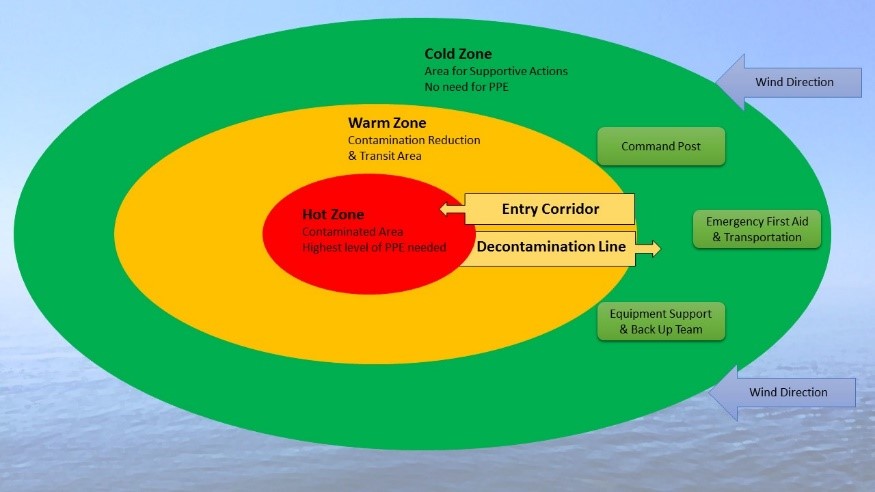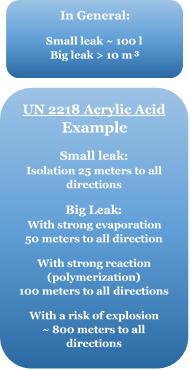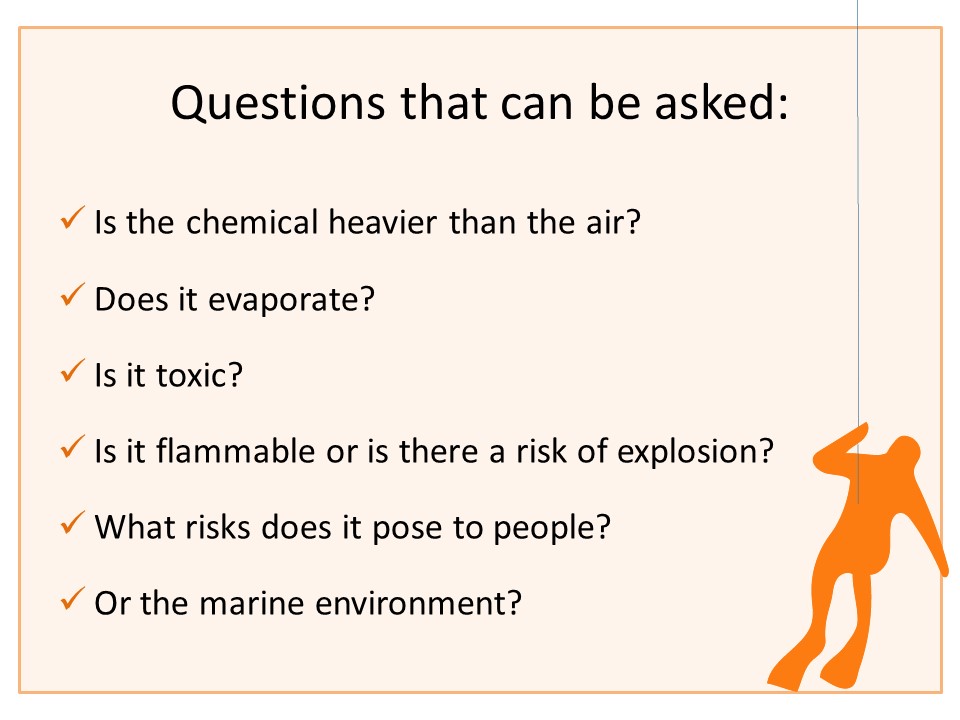Determination of the Restriction Area and Working Zones


The objective of a restriction area is to avoid additional, collateral damage and to ensure efficient and safe SAR operations. The Restriction Area is the SAR operational area around the Distress Vessel (DV). Within this operational area, the Search and Rescue Mission Coordinator (SMC) will define the working zones (Hot, Warm and Cold) related to the particular rescue mission in question and its operatives. The DV captain again is responsible for defining these areas within his/her ship. All of these areas can grow or decrease according to new information and situational needs.
In HNS incidents where there is a risk of flammable, explosive and/or toxic cloud, the dangerous area has to be isolated both from the maritime and air traffic. In this case, the restriction area is done by formulating a hemisphere area around the distress vessel.
In general, only Search and Rescue Units (SRU) with capability to enter dangerous atmosphere are allowed to enter a hemisphere area with a risk of contamination.
The initial determination of the above is dependent on, for example:
- The first information received by the RCC from DV
- The properties of the HNS involved
- Severity degree of the incident (e.g. size of leakage or damage to container)
- Current weather conditions and weather forecast
- Possible distress vessel maneuvers (e.g. protecting living quarters by turning upwind).
The information provided by the DV Captain and the assistance requested by the DV will act as a foundation for the rescue mission. Therefore, in order for the rescue authorities to prepare and resource the rescue mission efficiently, they need as accurate information about the incident as possible. When feasible, things like pictures of the sources of danger, detailed descriptions of spillage and/or damage to container, relevant factors affecting the current state (e.g. leakage under control or not, leakage increasing or decreasing) and possible risks that worsen the situation (increasing container temperature, high waves, sunlight or other environmental factors, other dangerous cargo nearby) etc.
Note! It has to be kept in mind, that the information gathering should not risk the safety of the incident response crew or deteriorate the efficiency of response actions onboard. The Captain is responsible to make decisions about the priority of required actions.

As it takes time for external help to arrive to the incident scene, the actions done by the crew are essential for the success and efficiency of the whole SAR operation. Therefore, the Captain should ensure that the SMC is updated systematically about the state onboard as well as about actions done and planned by the response crew. In severe, high-risk operations such as HNS incidents, it is necessary that all parties work for the same goal, which is enabled by efficient and timely communication.
Determining the Restriction Area and Working Zones Onboard
The Captain of the distress vessel is responsible for restricting operational areas and defining working zones onboard. These areas need to be defined before deploying response actions onboard. If the DV response team has a risk of being contaminated, the rescue operation should not be deployed until it has been ensured that the decontamination line is ready with possible additional air. Hence, the Captain of the ship needs to determine where the decontamination is taking place to decontaminate both, the chemical response team, and the possible contaminated, injured people. S/he needs to determine also both, entry and exit points, between different working zones, and the location for emergency first aid. Hence, in order to ensure the safety of DV emergency response team, there cannot be any chemical response operations onboard with a risk of getting contaminated, without decontamination possibilities and definition of working zones, which are determined by the Captain. The Captain should also ensure that the SMC receives all relevant information related to the onboard restriction areas and working zones.
Defining the Working Zones
The objective of defining the working zones is to avoid additional, collateral damage and to ensure the safety of onboard operatives.
Hot Zone
Hot Zone is an area where the risk for contamination and probability for exposure to hazardous substances is highest. Only emergency responders can enter this area with highest level of PPE required in the particular situation. The size of the Hot Zone is dependent on the properties of the HNS involved, size of the leakage, related hazards and risks (e.g., is the substance toxic? Is it flammable or is there an explosion hazard? The level of PPE needed?), weather conditions, location on the ship and isolation possibilities, e.g., by closing fire doors etc.
Warm Zone
Warm Zone is an area surrounding the Hot Zone and lies as a “buffer” between Cold and Hot Zones. This area is the transition area where responders enter and exit other zones, and where decontamination takes place. There is a risk of contamination in the Warm Zone, hence some level of protective equipment is needed. The level and nature of protective equipment is determined on case by case basis. Also, for example, if contaminated people are transported through stairways to a Decontamination station, these stairways could be determined to be a Warm Zone, as there could be a risk for secondary contamination resulting from moving, contaminated rescue mission responders and contaminated people.
Warm Zone is also the area where all decontamination is done. Decontamination Area is built in the Warm Zone to operate as a “corridor” between Hot Zone and Cold Zone. All contaminated equipment, clothes, contaminated water etc., are left at the Warm Zone. When entering cleaned from the decontamination line, one enters the Cold Zone, where there, in principle, is no risk of being contaminated.
Cold Zone
In principle, Cold Zone is the area where there is/or should not be a risk of contamination. This zone is the outermost part of the restriction area, and if such an area exists on the DV, it will be the “clear-air” area and a place of safety for passengers and crew. There is no need for personal protective equipment in this area. In general, the command post is located on the Cold Zone along with support equipment. It should be, if possible, located upwind of the Hot Zone.
Entry and Exit Points
Both entry and exit points between zones have to be predefined and controlled. Moving from one zone to another is always done in a controlled manner through these predefined entry/exit points, and when possible, these points should be located upwind. Exit from Hot Zone towards Cold Zone should always be done through the decontamination line in the Warm zone.

Sometimes in mass contamination situations, the facilities in the distress vessel are not sufficient enough to decontaminate all contaminated people. In these cases, the decontamination line can be established on a Search and Rescue Unit that has chemical response capabilities. These decisions are done in cooperation between the DV Captain and the SMC with the assistance of chemical experts.
Defining the Size of Zones
The size of these zones are dependent on the situational factors in each case, the properties and potential risks of the HNS, size of the leak and location in the ship, environmental factors, weather conditions and wind direction.
The physical properties of the HNS determine how it will behave in an incident, and which kind of response measures are most effective. For more detailed information, please see Action Plan for HNS Pollution, Preparedness and Response by EMSA in the section Further Reading.
The IMDG Code defines initial Emergency Actions in the section EmS, found in the section Further Reading.

